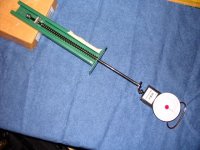Nice tools are great. A machined fixture,Chatillion force gage,etc,is great!!
But,if the main idea is to sort or check your springs,I'll toss out some "Gitterdone" ideas to work with. I have not used them,but I have thought about this .
You need something to go through the spring as "Guide and drawbar"
It could be a bridge timber spike,or a long bolt (unthreaded for the length of the spring)
It could even be a wooden dowel,sized to slip fit through the spring,with a few inches length protruding.You would need a "head" on it that would compress the spring. Drill for a cross pin ? put a nut or washer or other "stopper" between the cross pin and the spring? A section of cleaning rod,with the threaded ends? Use your imagination.A battery hold down bolt with the hook on the bottom and wing nut on the top would probably work.Wingnut on top,the load or fish scale on the hook.
Then you need a hole in something that this guide rod/drawbar will freely slip through,but the spring will not slip through the hole. The spring stops here!
The drawbar and spring are vertical,above the hole. The "head" feature of the drawbar is on top of the spring,and will compress it if the drawbar is pulled down,from below the hole.
Put a washer in a vise.Or drill a hole in angle iron,hardwood,whatever,and put it in a vise so your drawbar with a spring on it can be stood up vertical through the hole,without the spring going through.Material doesn't matter. You just need a fixed hole in something that the drawbar can be pulled down through it to compress the spring.
Now,to apply a measurable force...
Drill a cross hole through the lower tip of the drawbar. Put an "S" hook in it.Or
use the hook on the battery bolt.You just need some means to attach a downward load to the drawbar.
You can mark the 1.810or any other compressed length on the drawbar,measuring down from the head.
You can hook a bucket to it and pour in water or shot,you can use a fish scale,
Anything that will apply the load on the spring in a measurable way.
You can even work from volume of water and weight per oz. A "2 gallon " spring.
If you have a pencil and a ruler,a reference mark can be made for lengths of compression.
Depending on what you are trying to achieve,you can accurately measure a numeric value,of "16 lbs at 1 in compression" or you can record"My new Wilson 16 lb spring was 2 gallons plus one cup of water with this calibrated bucket when it was new.
Or you can compare 5 springs easily.


